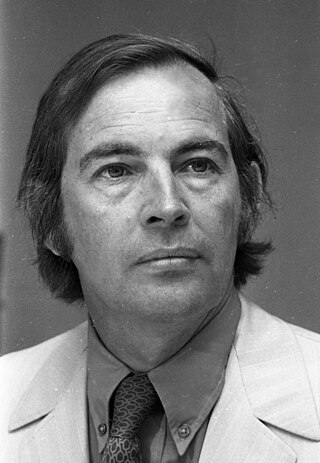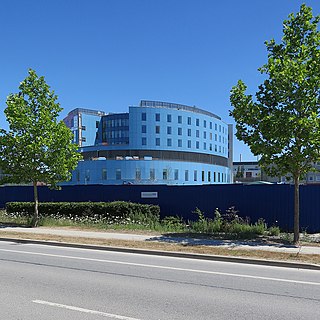Related Research Articles

Christiaan Neethling Barnard was a South African cardiac surgeon who performed the world's first human-to-human heart transplant operation. On 3 December 1967, Barnard transplanted the heart of accident victim Denise Darvall into the chest of 54-year-old Louis Washkansky who regained full consciousness and was able to talk easily with his wife, before dying eighteen days later of pneumonia, largely brought on by the anti-rejection drugs that suppressed his immune system. Barnard had told Mr. and Mrs. Washkansky that the operation had an 80% chance of success, an assessment which has been criticised as misleading. Barnard's second transplant patient, Philip Blaiberg, whose operation was performed at the beginning of 1968, returned home from the hospital and lived for a year and a half.

William Castle DeVries is an American cardiothoracic surgeon, mainly known for the first transplant of a TAH using the Jarvik-7 model.
Cardiothoracic surgery is the field of medicine involved in surgical treatment of organs inside the thoracic cavity — generally treatment of conditions of the heart, lungs, and other pleural or mediastinal structures.

The Toronto General Hospital (TGH) is a major teaching hospital in Toronto, Ontario, Canada and the flagship campus of University Health Network (UHN). It is located in the Discovery District of Downtown Toronto along University Avenue's Hospital Row; it is directly north of The Hospital for Sick Children, across Gerrard Street West, and east of Princess Margaret Cancer Centre and Mount Sinai Hospital. The hospital serves as a teaching hospital for the University of Toronto Faculty of Medicine. In 2019, the hospital was ranked first for research in Canada by Research Infosource for the ninth consecutive year.

Lung transplantation, or pulmonary transplantation, is a surgical procedure in which one or both lungs are replaced by lungs from a donor. Donor lungs can be retrieved from a living or deceased donor. A living donor can only donate one lung lobe. With some lung diseases, a recipient may only need to receive a single lung. With other lung diseases such as cystic fibrosis, it is imperative that a recipient receive two lungs. While lung transplants carry certain associated risks, they can also extend life expectancy and enhance the quality of life for those with end stage pulmonary disease.
Bruce A. Reitz is an American cardiothoracic surgeon, best known for leading the first combined heart-lung transplantation in 1981 with pioneer heart transplant surgeon Norman Shumway. He obtained an undergraduate degree at Stanford University a medical degree at Yale Medical School and completed an internship at Johns Hopkins Hospital (1971) and residencies and fellowships at Stanford University Hospital the National Institutes of Health (1974). He joined the surgical faculty at Stanford University (1978) then became chief of cardiac surgery at Johns Hopkins University (1982–92) and Chairman of the Department of Cardiothoracic Surgery at Stanford (1992–2005). In 1995 he conducted another pioneering operation: the first Heartport procedure, using a device that allows minimally invasive coronary bypass and valve operations. Reitz also played a major role in the resident education program at Stanford, which he reorganized and maintained.

Royal Papworth Hospital is a specialist heart and lung hospital, located on the Cambridge Biomedical Campus in Cambridgeshire, England. The Hospital is run by Royal Papworth Hospital NHS Foundation Trust.
Cardiothoracic anesthesiology is a subspeciality of the medical practice of anesthesiology, devoted to the preoperative, intraoperative, and postoperative care of adult and pediatric patients undergoing cardiothoracic surgery and related invasive procedures.

Randall Bertram Griepp was an American cardiothoracic surgeon who collaborated with Norman Shumway in the development of the first successful heart transplant procedures in the U.S. He had an international reputation for contributions to the surgical treatment of aortic aneurysms and aortic dissection and in heart and lung transplantations. He received nearly $8 million in grants from the National Heart, Lung, and Blood Institute.

NYU Langone Health is an academic medical center located in New York City, New York, United States. The organization consists of the NYU Grossman School of Medicine and NYU Grossman Long Island School of Medicine, both part of New York University (NYU), and more than 300 locations throughout the New York metropolitan area, including six inpatient facilities: Tisch Hospital; Kimmel Pavilion; NYU Langone Orthopedic Hospital; Hassenfeld Children's Hospital; NYU Langone Hospital – Brooklyn; and NYU Langone Hospital – Long Island. It is also home to Rusk Rehabilitation. NYU Langone Health is one of the largest healthcare systems in the Northeast, with more than 46,000 employees.
James D. Hardy was a United States surgeon who performed the world's first lung transplant into John Russell, who lived 18 days. The transplant was performed at the University of Mississippi Medical Center in Jackson, Mississippi on June 11, 1963.

A heart transplant, or a cardiac transplant, is a surgical transplant procedure performed on patients with end-stage heart failure or severe coronary artery disease when other medical or surgical treatments have failed. As of 2018, the most common procedure is to take a functioning heart, with or without both lungs, from a recently deceased organ donor and implant it into the patient. The patient's own heart is either removed and replaced with the donor heart or, much less commonly, the recipient's diseased heart is left in place to support the donor heart.
Ann Harrison was the recipient of the world's first successful human double lung transplant. She survived for almost fifteen years after the surgery and died of unrelated causes.

Shaf Keshavjee is a Canadian surgeon and the current Surgeon-in-Chief at University Health Network in Toronto, the Director of the Toronto Lung Transplant Program, as well as a clinical scientist and professor with the University of Toronto.
David John Sugarbaker was an American physician who was chief of the division of general thoracic surgery and the director of the Baylor College of Medicine Lung Institute at CHI St. Luke's Health–Baylor St. Luke's Medical Center in Houston, Texas. He was an internationally recognized thoracic surgeon specializing in the treatment of mesothelioma, the surgical management of malignant pleural mesothelioma, and treatment of complex thoracic cancers.
Robert Samuel Decosta Higgins MD, MSHA is an American surgeon working with heart–lung transplants. He is president, Brigham and Women's Hospital; Executive Vice President, Mass General Brigham.
Abbas Ardehali is an Iranian-American cardiothoracic surgeon. He is the surgical director of UCLA's Heart, Lung, and Heart-Lung Transplant programs, and was the principal investigator behind technology that allows for the transportation of a breathing human heart or lung for an extended period of time.

Prafulla Kumar Sen MD was an Indian vascular and cardiothoracic surgeon, who led the world's sixth attempt of human heart transplant and India's first in 1968. It dubbed him the fourth surgeon in the world to carry out this operation.

Stuart William Jamieson is a British cardiothoracic surgeon, specialising in pulmonary thromboendarterectomy (PTE), a surgical procedure performed to remove organized clotted blood (thrombus) from pulmonary arteries in people with chronic thromboembolic pulmonary hypertension (CTEPH).

Keith Reemtsma was an American transplant surgeon, best known for the cross-species kidney transplantation operation from chimpanzee to human in 1964. With only the early immunosuppressants and no long-term dialysis, the female recipient survived nine months, long enough to return to work.
References
- ↑ "Joel D. Cooper | Faculty | About Us | Perelman School of Medicine | Perelman School of Medicine at the University of Pennsylvania". www.med.upenn.edu. Retrieved 2018-02-27.
- 1 2 Joel D. Cooper - Faculty Profile